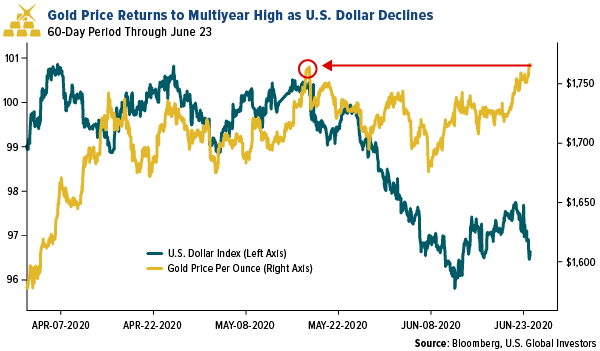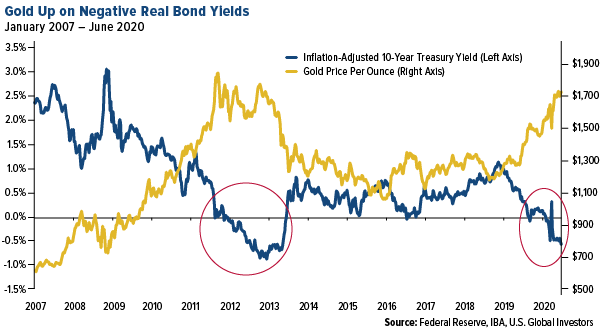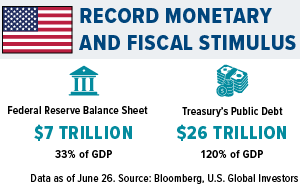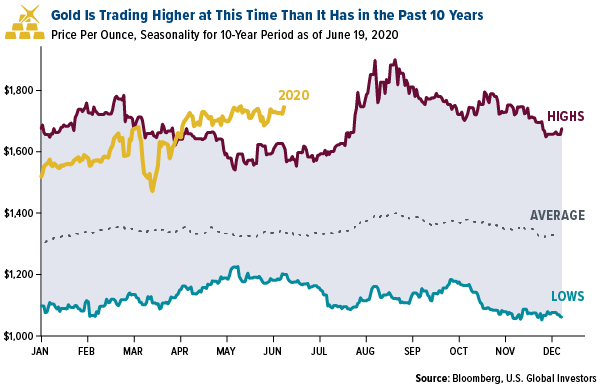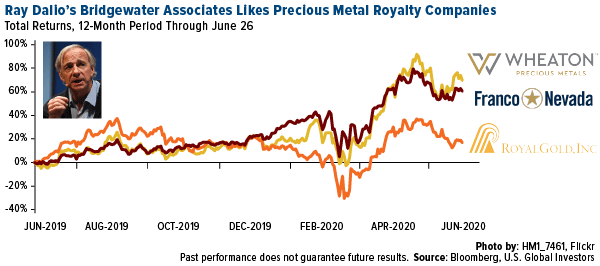
A “perfect storm” of surging government debt levels, plunging real bond yields, rising coronavirus cases and deteriorating economic forecasts pushed the price of gold to an eight-year high last week, and some analysts now project the metal to top its all-time high within the next 12 months.
Gold touched $1,778 an ounce last Wednesday, its highest level since February 2012 and coming within striking distance of the psychologically important $1,800 resistance level.
What drove the yellow metal’s price action was not just an alarming rise in confirmed virus infections—U.S. cases hit a new single-day record of more than 42,255 on Friday—but also a weakening U.S. dollar. The greenback declined the most in three weeks as the yen and euro strengthened amid gains in global shares.
LLooking more long term, gold continues to find support from negative yields, both real and nominal. The amount of negative-yielding government bonds around the world rose back above $13 trillion last week for the first time since March. The high of $18 trillion was set in August of last year.
The real 10-year Treasury yield traded as low as negative 0.66 percent last Tuesday, a level we haven’t seen since May 2013. As I’ve shown a number of times before, gold trades inversely to bond yields, and when they turn negative, it’s like rocket fuel for the yellow metal.
IMF Lowers Its 2020 Economic Growth Forecast. More Money-Printing Ahead?
Meanwhile, the International Monetary Fund (IMF) lowered its economic growth forecast for 2020. The world economy is now projected to plunge nearly 5 percent this year, a downward adjustment of 1.9 percentage points from the IMF’s April forecast.
“The COVID-19 pandemic has had a more negative impact on activity in the first half of 2020 than anticipated, and the recovery is projected to be more gradual than previously forecast,” IMF economists wrote in the June 24 report.
This could spur even more monetary and fiscal stimulus from world central banks and governments, which is already unprecedented. The Bank of England (BoE) recently added to its bond-buying program, and the Federal Reserve has signaled that it will be keeping rates near zero.
|
|
Get this: As of right now, the Fed’s balance sheet stands at $7 trillion, or 33 percent of U.S. GDP. And earlier this month, the Treasury’s public debt soared past $26 trillion, an incredible 120 percent of the entire U.S. economy.
This isn’t sustainable, obviously, and some analysts now see dollar-denominated gold hitting a new all-time high in the next 12 months, even in a risk-on environment. Both Morgan Stanley and Citigroup maintain their call for $2,000 gold by mid-2021.
London-based research firm Edison goes even further. In a note dated June 23, analysts there commented that gold should be near $1,900, “with the potential for this to rise to in excess of $3,000.”
Gold’s Best Year Ever (So Far) in Dollar Terms
So far in 2020, physical gold is comfortably the best performing major asset. It’s outperformed not just the S&P 500 but also the U.S. dollar, emerging markets, Treasuries and high-yield corporate bonds.
In fact, this is gold’s best year ever so far in dollar terms. The chart below shows you all the highest highs (the red line) and lowest lows (teal line) between January and December from the past 10 years. The yellow line is gold’s price action in 2020, and as you can see, it’s trading higher at this point than it ever has in the month of June.
Historically, June has been a relatively weak month for gold, making it a good time to consider adding the metal to your portfolio in anticipation of seasonal asset appreciation. India, the world’s second largest purchaser of gold after China, has two big events coming up that in years past have pushed the metal’s price higher thanks to increased demand. I’m talking, of course, about Diwali and the Indian wedding season, both of which I’ve written and spoken about numerous times.
The question this year, though, is how much of an impact the pandemic will have on these huge cultural celebrations, and if gold will see a difference.
Will COVID-19 Derail the $50 Billion Indian Wedding Season?
Like the U.S., India just had its biggest one-day spike in new coronavirus cases, with approximately 20,000 reported on Monday. The Asian country is the fourth worst affected country after the U.S., Brazil and Russia, and its death toll is the eighth worst.
Again, gold demand in anticipation of the upcoming Diwali celebration and Indian wedding season has helped prices move higher heading into August and September. Were this a “normal,” non-pandemic year, the added demand may have been such that gold could top $1,800 an ounce or more.
There are already reports of some Indian couples delaying or outright cancelling their 2020 wedding plans, not just as a precautionary measure but also to wait it out and tie the knot under more ideal conditions. Indian weddings have traditionally been grand affairs attended by large numbers of family members, a clear health risk in the age of COVID-19.
For couples who are choosing to move forward with wedding plans, there’s a new “essential”: matching face masks.
As a result of the cancellations, gold consumption in India could potentially fall as much as 50 percent in 2020 compared to last year, from 690.4 metric tons in 2019 to between 350 and 400 tons this year, according to one forecast.
Although this may end up being the case, it’s worth remembering that gold still plays a massive role in many other corners of Indian culture. Indians still save in gold, with as much as 75 percent of Indian savings invested in the precious metal, according to Incrementum. Private households in the country are estimated to be the single largest gold hoarders in the world, with some 24,000 metric tons. That’s more than three times the amount the U.S. has in its official.
There could also be some good news thanks to a healthy monsoon season, which begins this month and continues through September. It’s been estimated that a third of Indian gold demand comes from rural farmers, whose crop revenue depends on the rains delivered by a good monsoon.
This year the monsoon is forecast to be normal, and already Indian sugar producers are having an excellent season, with exports at a record volume for the second year in a row. I believe this is constructive for gold demand.
Fore more on gold’s seasonality, watch my video on buying the dips by clicking here.
Royalty Companies a Smart Way to Play the Gold Rally
When it comes to getting exposure to gold, my favorite way continues to be royalty and streaming companies. Industry leaders Franco-Nevada and Wheaton Precious Metals have soared over the past 12 months, with Franco up 63.6 percent through today, Wheaton up 71.6 percent.
I’m not the only one who likes these companies, though. Ray Dalio, the billionaire hedge fund manager of Bridgewater (the largest hedge fund in the world), is a big gold bug. According to Bridgewater filings for the March quarter, SPDR Gold Shares (GLD), which invests in physical gold, stood as Dalio’s second largest holding, valued at more than $600 million.
Included in his holdings are the three companies in the chart above, Franco, Wheaton and Royal Gold, with a combined value of $12.6 million. Go gold!
There’s Still Time to Register!
Speaking of gold royalties, I will be participating in today’s webinar called “Maximizing returns and minimizing risk investing in Gold Royalties.” The webinar will be held between 1:00 and 2:00pm Pacific time. I’ll be joined by Joe Mazumdar, editor and analyst at Exploration Insights. I hope you’ll join us! To register for this event, click here.
All opinions expressed and data provided are subject to change without notice. Some of these opinions may not be appropriate to every investor. By clicking the link(s) above, you will be directed to a third-party website(s). U.S. Global Investors does not endorse all information supplied by this/these website(s) and is not responsible for its/their content.
The S&P 500 Stock Index is a widely recognized capitalization-weighted index of 500 common stock prices in U.S. companies.
Holdings may change daily. Holdings are reported as of the most recent quarter-end. The following securities mentioned in the article were held by one or more accounts managed by U.S. Global Investors as of (03/31/2020): Wheaton Precious Metals Corp., Franco Nevada Corp., Royal Gold Inc.

